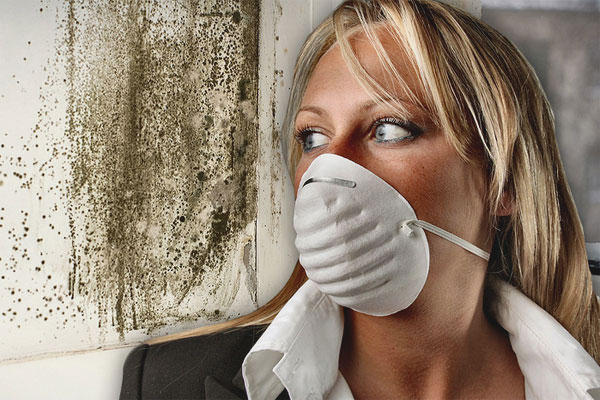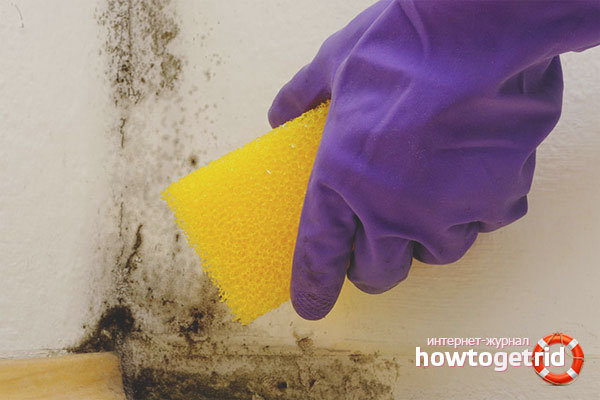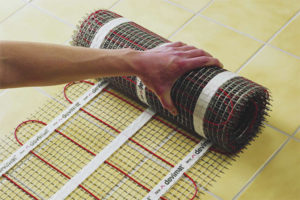The content of the article
Almost everyone knows that excess moisture is the cause of the formation of fungus in the room. This is not only ugly, but also very dangerous for the lives of all family members. Often a person may suffer from allergies or asthmatic attacks and not even suspect that the fungus may be the cause of the fungus on the wall in the bedroom or in the bathroom.
What causes fungus formation
The main problem is considered excessive humidity in the room or partitions. In addition, the reason may come from poor ventilation.
Mold appears not only on a tree, but also on a brick or stone. In the second and third cases, everything is not as scary as in the first, because it is very difficult to rid the wood of the fungus.
Several factors that cause mold on the walls:
- Freezing the walls of the building. If in the corners of the house you find black spots, then this indicates that the walls are poorly insulated. Dry them and re-plaster.
- Ground moisture, which manifests itself where the floor connects to the basement. Here you need to check the insulation of the walls of the foundation and, if necessary, carry out its repair or replacement.
- Breakdown of the water supply, as evidenced by the mold that has accumulated near the water pipes or near the bathroom. Drying can handle the problem.
- Leaking gutters on the gutter can be detected only when the drips went on the exterior plaster of the house.
- Damage to the ventilation system in the bathroom or in the kitchen, because it is here that humidity is constantly preserved. Regular airing should be carried out in the rooms.
How to carry out the treatment of the walls of the fungus
Often mold spreads on plaster, which should be processed. But before that, you need to check how well it keeps on the wall. This is done by tapping the walls with a hammer.If a deaf sound is heard in response, it means that the plaster layer needs to be completely changed, as it has moved away from the wall.
When the wall covering is reliable, it is simply treated with special antiseptics that kill the fungus. But here it is recommended to strictly comply with the instructions specified in the instructions for the drug.
Technology of work
- Dampen the wall with water to prevent mold from further spreading. Using a special brush, remove the fungus that appears along with the plaster layer. To improve the effect, the concrete can be cleaned with a substance that opens the pores of the cement.
- After the plaster remains are burned, the clean surface must be treated with an antiseptic. The wall is washed with a margin of 1 meter on all sides to kill all nascent pests. The solution can be applied with ordinary rollers, brushes or spray.
- The next stage is the primer of the walls by means of deep penetration, which has a fungicidal effect. When the surface is completely dry, apply the primer again. Next, the walls are plastered, plastered and trimmed.
If the fungus has already plentifully flooded the wall and penetrated deep into the plaster, then special hopes should not be placed on cosmetic treatment, because it will only relieve you of the problem for a short time.
How to choose a quality antiseptic
In today's market there are a lot of drugs that cope well with the fungus. In order to choose it correctly, you should carefully read the instructions and get advice from the seller.
It is necessary to take into account that there are such means that are struggling with some specific subspecies of mold. In order not to be trapped, you need to purchase a universal preparation that is suitable for use both inside and outside the building.
In specialized stores are sold and ready, and dry mixes. You can dissolve them with paint thinner, water or turpentine.
It is worth closer to talk about antiseptic substances with a fungicidal effect:
- Atlas mykos - a drug that perfectly copes not only with the fungus, but also fights lichens, mosses and algae. You can buy it in a concentrated form, and apply in buildings where there is high humidity. In addition, the tool is allowed to process facades of houses.Before you start working with the drug, it must be diluted with water 1: 3. If you plan to process the mineral surface, the ratio should be 1: 6.
- Spectrum Fungicide - A substance that cleans fungus on wood, plaster and varnish. It is used inside and outside facilities.
- Xiolat - a reliable drug that quickly copes with overgrown mold and penetrates into any material: wood, brick, stone.
- Teflex - the most powerful tool struggling with moldy walls, which can be described as environmentally friendly and long lasting. That is why it does not pose a danger to people or pets.
- FILASMUFFY - a drug that comes in the form of a spray and perfectly copes with mold on wallpaper and brick.
- Impregnation Snowball - this substance is a threat to fungus, lichen and moss. It is appropriate when working with brick, plaster and varnished surfaces. It is possible to apply both in the house, and on the street.
- Dali - universal antiseptic, which is quickly absorbed into the wall and is often used to prevent the appearance of fungus.
- Biotol - spray - most often used in the kitchen, balcony and in premises intended for washing clothes.
- Olympus ideal for rooms with increased dampness: basement, cellar, bathroom.
Before buying any drug, it is worthwhile to accurately calculate the square of the room, so that you do not have to run for additional packaging several more times.
How to deal with the fungus with the help of folk methods
In addition to chemicals that are far from being welcomed by all people, it is possible to get rid of the mold with folk remedies, recipes of our mothers and grandmothers.
It is worth talking about each of them in more detail:
- The use of cryosote, famous for its characteristic fungicidal effect.
- Making solutions that perfectly cope with the mold: take 2 liters of vinegar essence and 0.5 kg of blue vitriol, mix everything and process the walls with a mass.
- 2 kilograms of sodium Florida, 750 grams of vitriol are also good at fighting fungi on the walls of your rooms.
- 1 kilogram of borax, 500 grams of boric acid and 1.5 liters of vinegar will help you to forget about the mold.
Before using the prepared means, it is worth warming them up to 80 degrees, dip the roller in them and treat the problem area. Leave the walls for impregnation and complete drying. Re-processing is recommended after 30 days.
If you have to process the walls of brick, then there are several methods for this: mix hydrogen peroxide, soda, a mixture of vinegar and water, a mixture of alcohol and glycerin, alkali and bleach. With the resulting mass, spread the problem area and let it soak.
Measures to prevent the occurrence of fungus
- Full warming of walls of the house both from within, and outside.
- It is always good to carry out the heating of all the rooms in the house, even non-residential ones.
- It is recommended to purchase an air conditioner that has the function of air drying.
- In advance to consider a very high-quality ventilation of the room.
- Try not to dry wet things in the room, but to carry them outside or on the balcony.
- In the kitchen as rarely as possible to use hoods.
What methods of personal protection should be used when working with chemicals
- Regular airing of the room.
- Use masks and gloves.
- Work in special overalls.
- Full exemption of the room from flowers and furniture.
In order to completely rid the premises of fungus and mold, you should carefully read the instructions to the tools or use the services of professionals.
The quality of the work done depends on the knowledge of the process of mold formation and its further spread. Most newcomers in the repair business are often interested in how to properly deal with the fungus and do it right, because the result of labor depends on their experience.
Video: mold removal in 4 minutes













To send